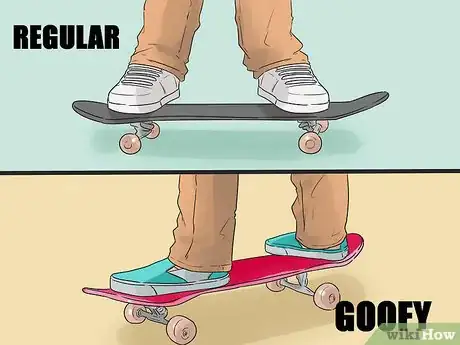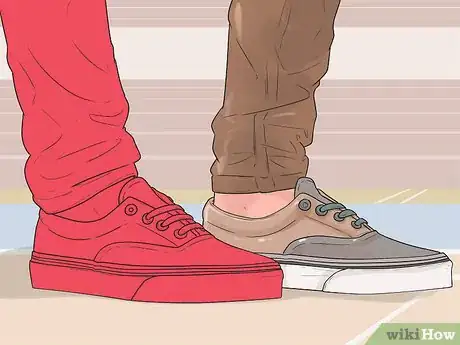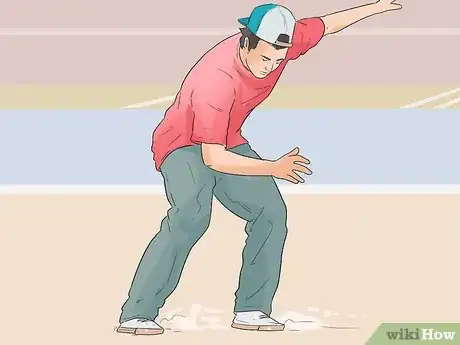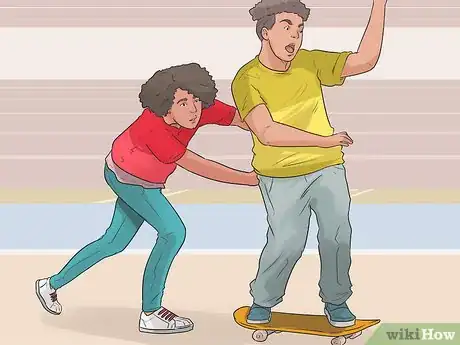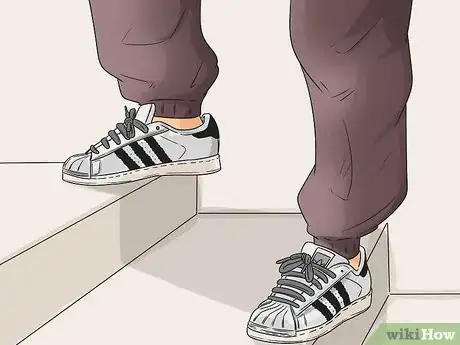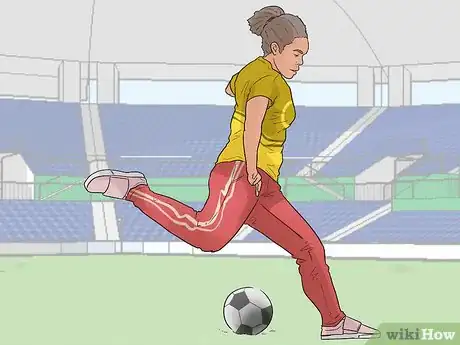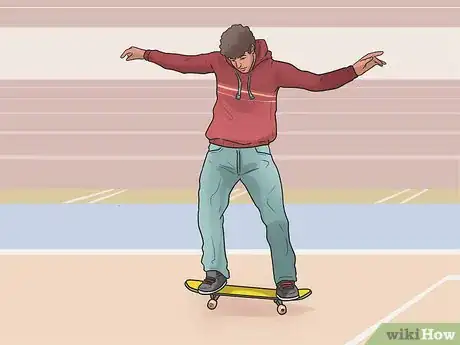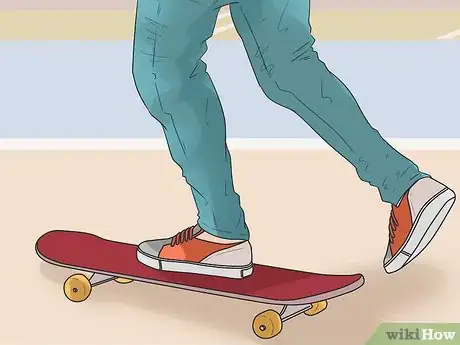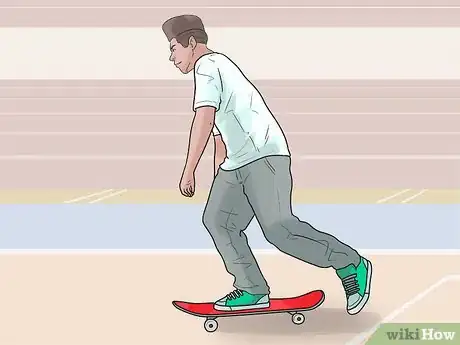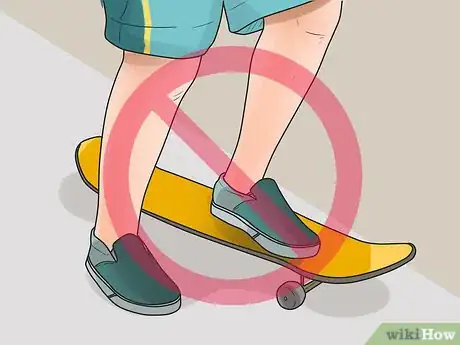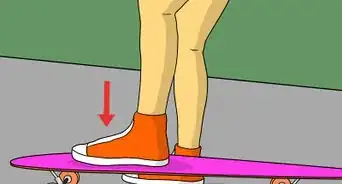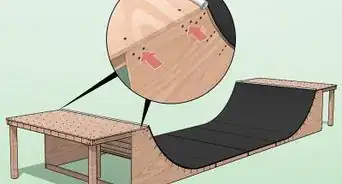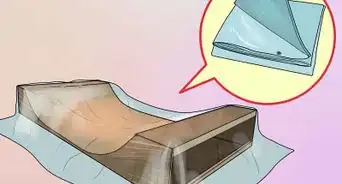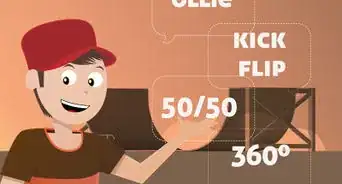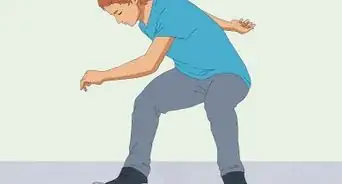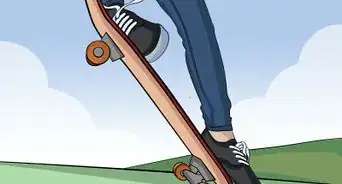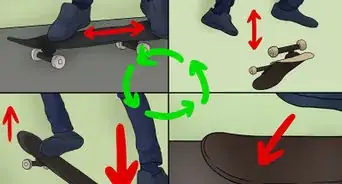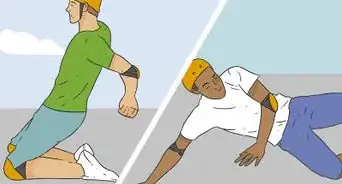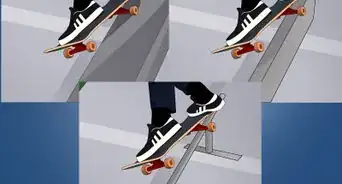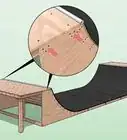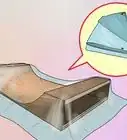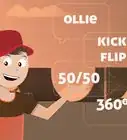This article was co-authored by Kent Bry and by wikiHow staff writer, Amber Crain. Kent Bry is a certified ski and snowboarding instructor and the director of Adventure Ski & Snowboard, a school based in the San Diego, California metro area. With over 50 years of skiing and snowboarding performance and instruction experience, Kent is certified by the Professional Ski Instructors of America (PSIA). Adventure Ski & Snowboard is a member of the PSIA and the American Association of Snowboard Instructors (AASI). Kent holds a BS in Recreational Therapy from San Diego State University and is also a California-registered recreational therapist.
There are 7 references cited in this article, which can be found at the bottom of the page.
wikiHow marks an article as reader-approved once it receives enough positive feedback. In this case, 81% of readers who voted found the article helpful, earning it our reader-approved status.
This article has been viewed 354,827 times.
When learning board sports like skateboarding and snowboarding, the first thing you need to figure out is your stance. There are two possible stances – regular foot and goofy foot. “Regular” doesn't mean “correct.” Both stances are valid, although regular foot does tend to be more common. The easiest way to figure out your stance is to determine your dominant foot. This is very easy to do, once you learn how.[1]
Steps
Finding Your Natural Stance
-
1Recognize the difference between regular and goofy. These terms refer to the two stances used in board sports.[2] Your stance is which foot is in front of the other when you're riding. Regular means to stand on the board with your left foot forward. Your right foot will be behind it, near the tail of the board.[3] Goofy is the opposite of regular – your right foot is forward and your left foot is back near the tail.[4]
- The foot you choose to put in front affects which direction you'll be facing on the board.
- For example, if a regular skater and a goofy skater were riding side by side, they'd be facing opposite directions.[5]
-
2Know your dominant foot. When standing on a board, you'll want your dominant foot to go in the back, since it's stronger and does most of the pushing, turning, etc. If you are right-handed, it's highly likely that your dominant foot is your right foot. This would mean your left foot goes in front and your stance is regular. This is usually how it works out, but not always.[6]
- Some people who are right foot dominant prefer riding goofy (right foot forward). Some people who are left foot dominant prefer riding regular (left foot forward). It's uncommon, but it does happen.
- In snowboarding, you'll primarily balance your weight more on your front foot.[7]
- Try a few simple tests to determine or confirm your dominant foot.
Advertisement -
3Run and slide. One of the easiest and most reliable ways to determine your dominant foot is the “slide” test. Put on a thick pair of socks and find a smooth, hard-surfaced floor. Take a running start and gain a little speed. When you're ready, switch from running to sliding. Take the final stride and then land flat-footed on both feet, balancing yourself as you slide across the floor in your socks.[8]
- Usually, the foot that lands in the front will be your dominant foot on the board.[9]
- Make sure you are in a room with enough open space to perform this test properly.
-
4Have a friend push you from behind. Stand naturally with your feet even and close together. Ask a friend to gently push you from behind. Try your best not to anticipate the push. You'll feel like you're falling, and one of your feet will naturally try to brace your fall. The foot that you catch yourself with is usually your dominant foot.[10]
- If you don't have a friend around, you can perform the “lean” test by yourself. Stand with your feet together. Slowly lean forward.
- Keep leaning until you feel like you're going to fall. The foot you use to catch yourself is probably your dominant foot.[11]
- Be sure to perform this safely. Your partner should push you gently. Wear knee pads, just in case you aren't able to catch your fall.
-
5Stand at the bottom of a staircase. Have both of your feet flat on the ground and side by side. Have someone yell “go” and then start running up the stairs. The foot that lands on the bottom stair first will most likely be your dominant foot.[12] Try it a couple of times in a row to see if you react the same each time.
- You can also try this by approaching a flight of stairs at a normal walking pace. The foot you instinctively use on the first step is your dominant foot.
- Try it both ways to see which foot is more comfortable.
-
6Drop-kick a soccer ball. A basketball or football will work fine too. Hold the ball out in front of you with both hands. Imagine that you have to kick this ball to score a goal. Drop the ball out in front of you and then kick it. The foot that you instinctively kick with is probably your dominant foot.[13]
- Repeat the exercise a few times to see if you get the same results.
Confirming Your Stance
-
1Stand on the board and have someone roll you. Have a friend stand in front of you. Get on the board and stand with one foot in front of the other. Put the foot you think is dominant in the back and the other forward. Once you're on, grab your friend's hands to steady yourself. Have them slowly roll you in the direction of your lead foot to see how it feels.[14]
- Then switch feet and try out your other foot as the lead.
- Do this several times until you're sure which stance is the most comfortable for you.
-
2Test how your dominant foot performs. Make sure to wear a helmet and protective gear. Find a nice, open space where you can work easily. Mount your board very carefully, putting what you think is your lead foot in its position at the back of the deck. Slowly lower your back foot to the ground. Use your back leg to push yourself forward slowly and cautiously.[15] Roll a few inches and then stop. Then try it again.
- How does it feel? Are you comfortable? Does it feel natural or awkward?
- Now switch the position of your feet and try it the other way. Does that feel more or less comfortable?
-
3Stick to your confirmed stance. Once you've figured out your stance, avoid switching back and forth during practice. Make that your official stance and start learning how to ride. After you've worked out your stance, the learning part can really begin because you are able to get comfortable.
- Your stance for one board sport will most likely be your dominant stance for all other board sports, such as windsurfing, snowboarding, wakeboarding and so on.[16]
- If you already know your stance, it makes learning another board sport that much easier!
Perfecting Your Stance
-
1Practice a stable riding stance. Start out on a level surface. Get into your dominant stance and practice pushing off. Put your front foot on the board, right behind the front bolts. Think of pushing off as taking a very slow step – lift your (dominant) pushing foot, then shift your balance to your front foot, which is still on the board. Place your pushing foot down in front of your board foot and then push back at the ground.
- At first, try pushing off and lifting your back (dominant) foot into position at the back of the board. Stay there and ride out the skateboard until it stops on its own. How does your stance feel now?
- When you first start out, being on the board feels a little awkward no matter how you're standing on it. Once your stance is stable, you'll start feeling more comfortable.
-
2Get comfortable with pushing off. After practicing your stable stance like that for a few sessions, it should start feeling a little more natural. Once you feel stable after pushing off once, carefully start putting your back foot down when you run out of speed and then pushing off again. Work your way up to ten small pushes.
- When you feel you've mastered that, add a few longer pushes to gain a little speed.
- Make sure you are pushing smoothly and with confidence. You should now feel absolutely sure about whether you are a regular or goofy foot.
-
3Avoid being a mongo foot. Mongo foot is when you use the front foot as dominant and then push off with it while the back foot stays on the board. This is exactly the opposite of how it should be. Your front foot should stay on the board, and your back (dominant) foot should push off. Sometimes when people are first learning, it feels more comfortable to do it the opposite way.
- If you catch yourself being a mongo foot, try to break yourself of it before it becomes too habitual.
- Improper form aside, pushing mongo foot can hinder you in setting up tricks and make you less stable on your board.
Expert Q&A
-
QuestionHow do you know which foot is dominant?
 Kent BryKent Bry is a certified ski and snowboarding instructor and the director of Adventure Ski & Snowboard, a school based in the San Diego, California metro area. With over 50 years of skiing and snowboarding performance and instruction experience, Kent is certified by the Professional Ski Instructors of America (PSIA). Adventure Ski & Snowboard is a member of the PSIA and the American Association of Snowboard Instructors (AASI). Kent holds a BS in Recreational Therapy from San Diego State University and is also a California-registered recreational therapist.
Kent BryKent Bry is a certified ski and snowboarding instructor and the director of Adventure Ski & Snowboard, a school based in the San Diego, California metro area. With over 50 years of skiing and snowboarding performance and instruction experience, Kent is certified by the Professional Ski Instructors of America (PSIA). Adventure Ski & Snowboard is a member of the PSIA and the American Association of Snowboard Instructors (AASI). Kent holds a BS in Recreational Therapy from San Diego State University and is also a California-registered recreational therapist.
Certified Snowboarding Instructor A good test is to have a friend come up behind you and gently push you forward. Whichever foot you step out with to catch yourself is probably your dominant foot.
A good test is to have a friend come up behind you and gently push you forward. Whichever foot you step out with to catch yourself is probably your dominant foot. -
QuestionMy right foot is my dominant foot, but I prefer to ride with my left foot in the back of my board. Is this okay?
 Nishat BlaghCommunity AnswerThat's fine, everyone has different preferences with what we find comfortable.
Nishat BlaghCommunity AnswerThat's fine, everyone has different preferences with what we find comfortable. -
QuestionIs there anything wrong with being goofy-footed?
 Community AnswerAbsolutely not -- it just means you are more likely to be left-handed, or you just feel more comfortable riding that way.
Community AnswerAbsolutely not -- it just means you are more likely to be left-handed, or you just feel more comfortable riding that way.
References
- ↑ Kent Bry. Certified Ski & Snowboarding Instructor. Expert Interview. 24 July 2020.
- ↑ https://sidewalkmag.com/skateboard-tricks/advice/skateboard-basics-sidewalk-basics.html
- ↑ Kent Bry. Certified Ski & Snowboarding Instructor. Expert Interview. 24 July 2020.
- ↑ Kent Bry. Certified Ski & Snowboarding Instructor. Expert Interview. 24 July 2020.
- ↑ http://www.thehouse.com/portal/am-i-goofy-or-regular-finding-out-your-natural-stance/
- ↑ http://www.skatexs.com/blogs/news/7494860-goofy-vs-regular-beginner-tips-for-kids-learning-to-skateboard
- ↑ Kent Bry. Certified Ski & Snowboarding Instructor. Expert Interview. 24 July 2020.
- ↑ http://www.skatexs.com/blogs/news/7494860-goofy-vs-regular-beginner-tips-for-kids-learning-to-skateboard
- ↑ http://snowboarding.transworld.net/how-to/how-to-find-out-if-you-snowboard-regular-or-goofy/#GqzVPJlfTBGTQIlz.97
- ↑ Kent Bry. Certified Ski & Snowboarding Instructor. Expert Interview. 24 July 2020.
- ↑ http://www.skatexs.com/blogs/news/7494860-goofy-vs-regular-beginner-tips-for-kids-learning-to-skateboard
- ↑ http://www.skatexs.com/blogs/news/7494860-goofy-vs-regular-beginner-tips-for-kids-learning-to-skateboard
- ↑ http://www.skatexs.com/blogs/news/7494860-goofy-vs-regular-beginner-tips-for-kids-learning-to-skateboard
- ↑ http://www.skatexs.com/blogs/news/7494860-goofy-vs-regular-beginner-tips-for-kids-learning-to-skateboard
- ↑ http://www.board-crazy.co.uk/skateboarding_beginners_1.php
- ↑ http://www.overthedune.com/what-are-goofy-and-regular-stances/
About This Article
The easiest way to figure out whether you’re regular or goofy foot is to do the “slide” test. Put on your thickest, slipperiest socks and find a smooth surface, like a hardwood floor. Once you’ve found a good spot, get a running start and slide across the surface and see where your feet land. Usually, the foot that you put in front will be your dominant foot when you skateboard or snowboard. If your right foot is dominant, that means you’re regular foot and should stand on your board with your right foot on the back. Alternatively, if your left foot is dominant, you’ll ride goofy with it near the tail. To confirm your test, hop on a board and try out both positions, noting which one feels more comfortable. For more help, like how to perfect your stance, read on!

